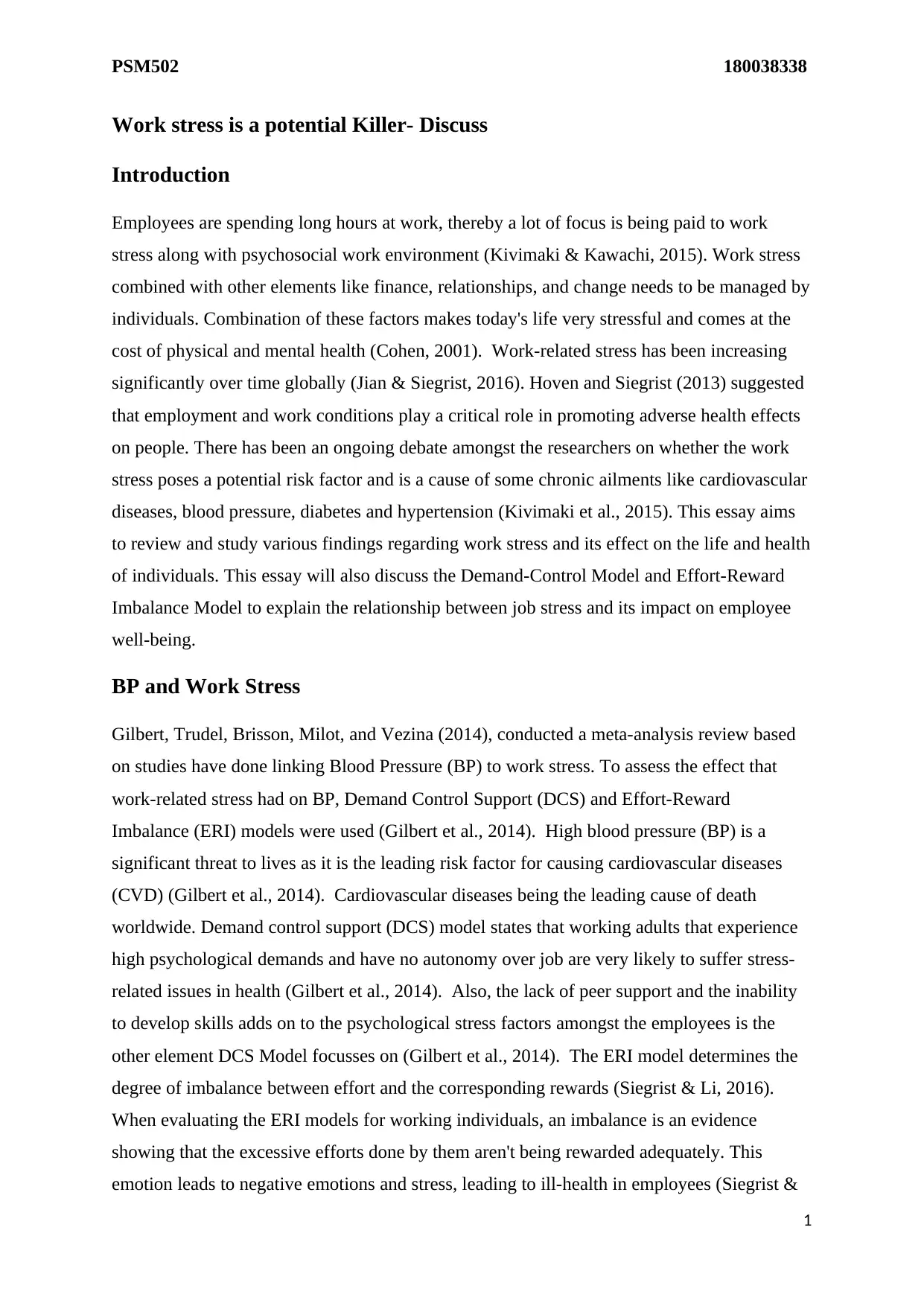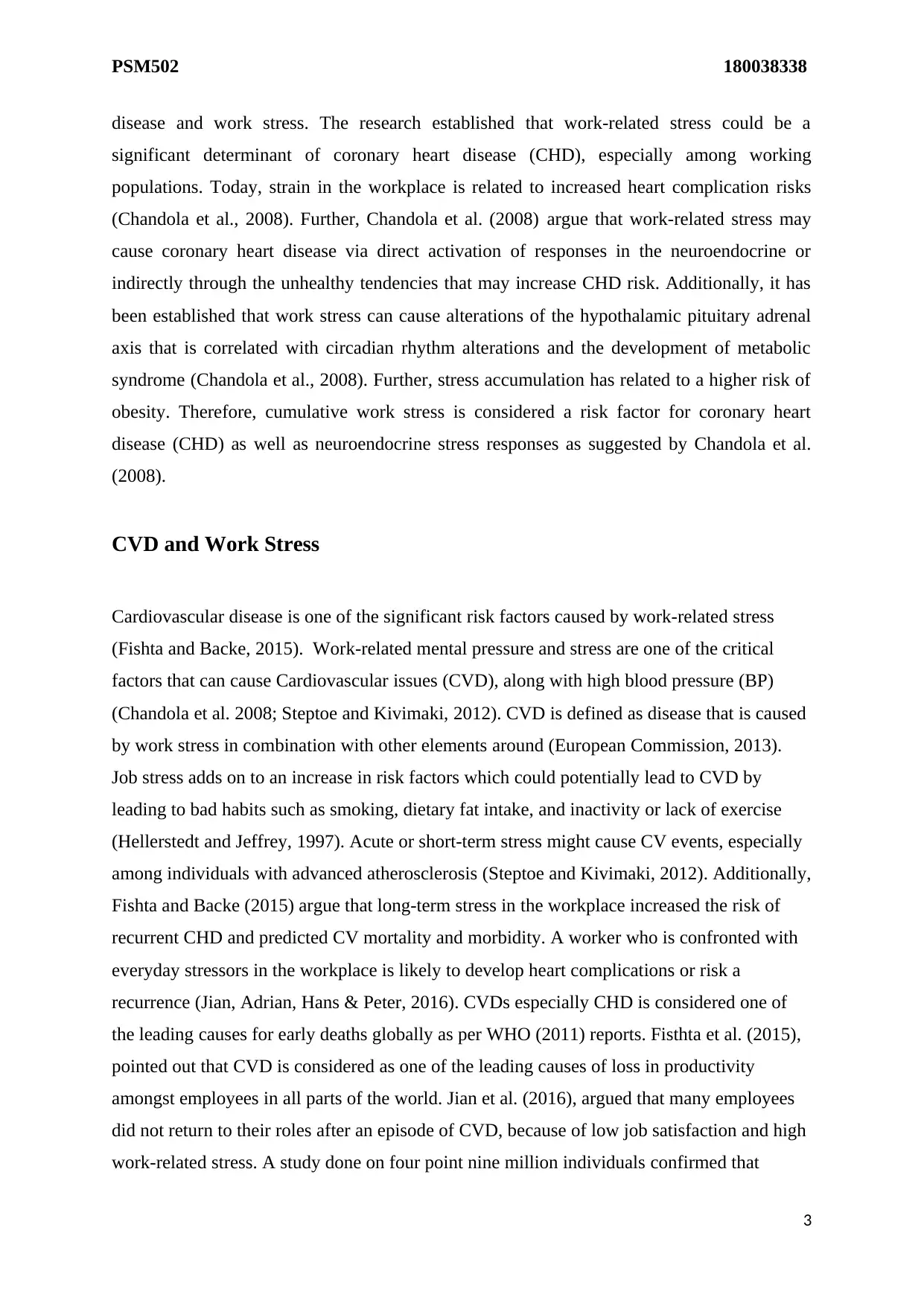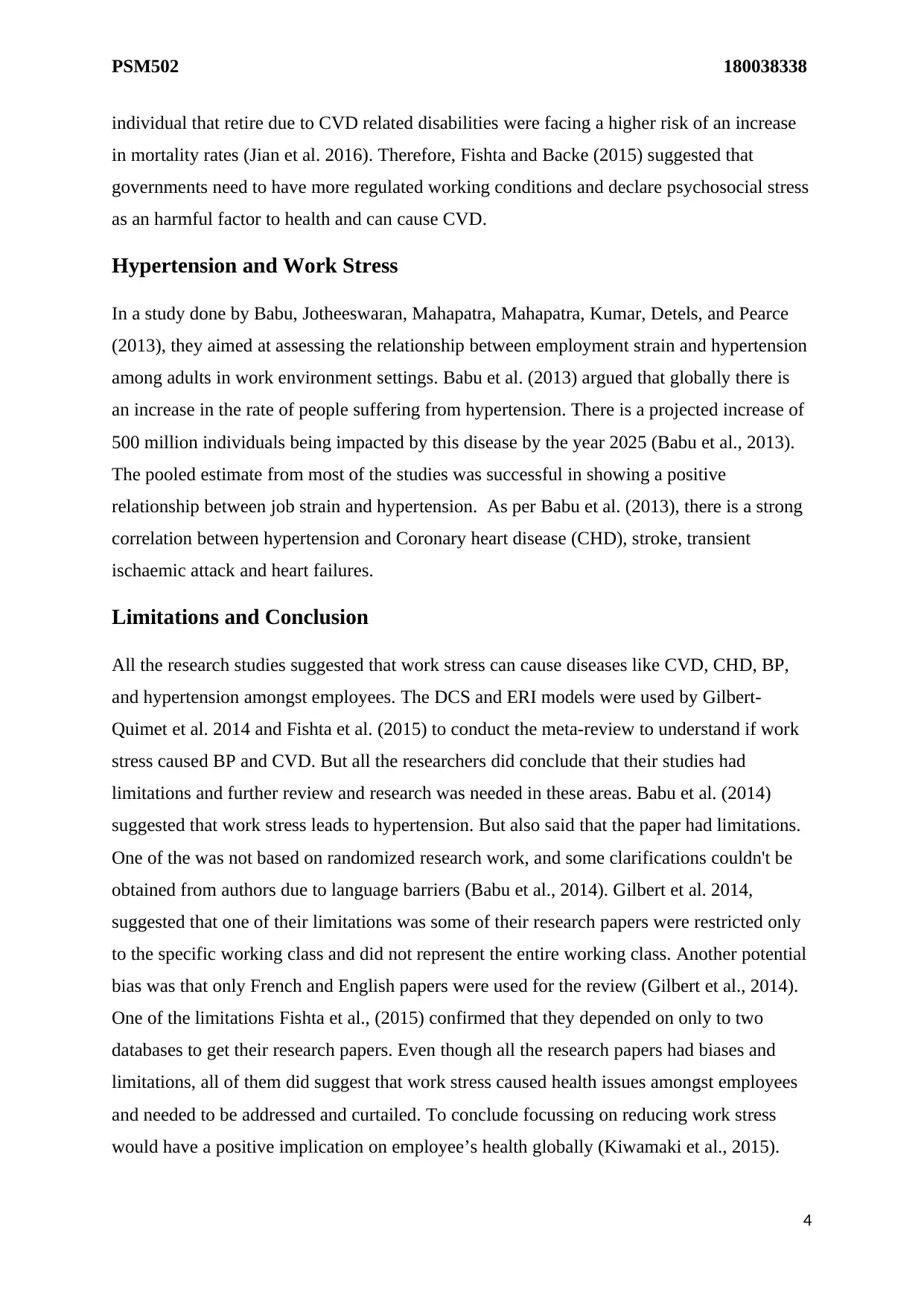Work Stress and its Effect on Employee Health: A Review
VerifiedAdded on 2023/04/24
|5
|1990
|104
AI Summary
This essay reviews the effect of work stress on employee health, including its potential to cause chronic ailments like cardiovascular diseases, blood pressure, diabetes, and hypertension. The Demand-Control Model and Effort-Reward Imbalance Model are discussed to explain the relationship between job stress and its impact on employee well-being.
Contribute Materials
Your contribution can guide someone’s learning journey. Share your
documents today.

PSM502 180038338
Work stress is a potential Killer- Discuss
Introduction
Employees are spending long hours at work, thereby a lot of focus is being paid to work
stress along with psychosocial work environment (Kivimaki & Kawachi, 2015). Work stress
combined with other elements like finance, relationships, and change needs to be managed by
individuals. Combination of these factors makes today's life very stressful and comes at the
cost of physical and mental health (Cohen, 2001). Work-related stress has been increasing
significantly over time globally (Jian & Siegrist, 2016). Hoven and Siegrist (2013) suggested
that employment and work conditions play a critical role in promoting adverse health effects
on people. There has been an ongoing debate amongst the researchers on whether the work
stress poses a potential risk factor and is a cause of some chronic ailments like cardiovascular
diseases, blood pressure, diabetes and hypertension (Kivimaki et al., 2015). This essay aims
to review and study various findings regarding work stress and its effect on the life and health
of individuals. This essay will also discuss the Demand-Control Model and Effort-Reward
Imbalance Model to explain the relationship between job stress and its impact on employee
well-being.
BP and Work Stress
Gilbert, Trudel, Brisson, Milot, and Vezina (2014), conducted a meta-analysis review based
on studies have done linking Blood Pressure (BP) to work stress. To assess the effect that
work-related stress had on BP, Demand Control Support (DCS) and Effort-Reward
Imbalance (ERI) models were used (Gilbert et al., 2014). High blood pressure (BP) is a
significant threat to lives as it is the leading risk factor for causing cardiovascular diseases
(CVD) (Gilbert et al., 2014). Cardiovascular diseases being the leading cause of death
worldwide. Demand control support (DCS) model states that working adults that experience
high psychological demands and have no autonomy over job are very likely to suffer stress-
related issues in health (Gilbert et al., 2014). Also, the lack of peer support and the inability
to develop skills adds on to the psychological stress factors amongst the employees is the
other element DCS Model focusses on (Gilbert et al., 2014). The ERI model determines the
degree of imbalance between effort and the corresponding rewards (Siegrist & Li, 2016).
When evaluating the ERI models for working individuals, an imbalance is an evidence
showing that the excessive efforts done by them aren't being rewarded adequately. This
emotion leads to negative emotions and stress, leading to ill-health in employees (Siegrist &
1
Work stress is a potential Killer- Discuss
Introduction
Employees are spending long hours at work, thereby a lot of focus is being paid to work
stress along with psychosocial work environment (Kivimaki & Kawachi, 2015). Work stress
combined with other elements like finance, relationships, and change needs to be managed by
individuals. Combination of these factors makes today's life very stressful and comes at the
cost of physical and mental health (Cohen, 2001). Work-related stress has been increasing
significantly over time globally (Jian & Siegrist, 2016). Hoven and Siegrist (2013) suggested
that employment and work conditions play a critical role in promoting adverse health effects
on people. There has been an ongoing debate amongst the researchers on whether the work
stress poses a potential risk factor and is a cause of some chronic ailments like cardiovascular
diseases, blood pressure, diabetes and hypertension (Kivimaki et al., 2015). This essay aims
to review and study various findings regarding work stress and its effect on the life and health
of individuals. This essay will also discuss the Demand-Control Model and Effort-Reward
Imbalance Model to explain the relationship between job stress and its impact on employee
well-being.
BP and Work Stress
Gilbert, Trudel, Brisson, Milot, and Vezina (2014), conducted a meta-analysis review based
on studies have done linking Blood Pressure (BP) to work stress. To assess the effect that
work-related stress had on BP, Demand Control Support (DCS) and Effort-Reward
Imbalance (ERI) models were used (Gilbert et al., 2014). High blood pressure (BP) is a
significant threat to lives as it is the leading risk factor for causing cardiovascular diseases
(CVD) (Gilbert et al., 2014). Cardiovascular diseases being the leading cause of death
worldwide. Demand control support (DCS) model states that working adults that experience
high psychological demands and have no autonomy over job are very likely to suffer stress-
related issues in health (Gilbert et al., 2014). Also, the lack of peer support and the inability
to develop skills adds on to the psychological stress factors amongst the employees is the
other element DCS Model focusses on (Gilbert et al., 2014). The ERI model determines the
degree of imbalance between effort and the corresponding rewards (Siegrist & Li, 2016).
When evaluating the ERI models for working individuals, an imbalance is an evidence
showing that the excessive efforts done by them aren't being rewarded adequately. This
emotion leads to negative emotions and stress, leading to ill-health in employees (Siegrist &
1
Secure Best Marks with AI Grader
Need help grading? Try our AI Grader for instant feedback on your assignments.

PSM502 180038338
Li, 2016). The model states that stress takes place in individuals due to lack of appreciation,
rewards, and jobs with high demands and low returns. Also, the lack of job security is another
factor that increases the stress amongst employees (Siegrist et al.1990; Siegrist 1996)
Based on the review and findings of their studies, Gilbert et al. (2014) suggested that that
psychosocial work factors lead to the elevation of BP. Constant exposure to high BP and
hypertension due to work amplify over time, and that triggers cardiovascular events. The
elevation of BP can successively lead to hypertension, stroke and arterial stiffness (Gilbert et
al., 2014). The adverse effects of psychosocial stressors occur due to the cumulative impact
of prolonged or multiple exposures. The sympathetic nervous system, which is the primary
mediator of the stress response is one of the pathways that activate the renin-angiotensin
system (Gilbert et al., 2014). Therefore, stress can stimulate the secretion of rennin as well as
increased plasma levels of angiotensin II that has a vital effect on blood vessel walls. This
study establishes a link between work stress and elevated BP, which in turn could lead to
CVD (Gilbert et al., 2014). Thereby the researchers suggested that the psychosocial elements
of work mentioned in the ERI and DCS models contributed to the elevation in BP and could
lead to CVD (Gilbert et al., 2014).
Siegrist & Li (2016), suggested that people who were over-committed to their jobs also were
at high risk of developing cardiovascular diseases and other symptoms like BP, atherogenic
lipids, increase in glucose levels and fibrinogen also building up towards CVD. The reduction
in natural killer cells compromised the immune system. The need to overcommit was linked
to the ERI model of (Siegrist et al. 1990 & Siegrist 1996), wherein individuals
overcommitted and overworked to get approval and receive recognition. This study helped in
suggesting a connection between the ERI model, health and the intrinsic component of the
model. Individuals who are exposed to more extended working hours are exposed to stressful
working conditions, and that causes the emergence of health complications (Lancet, 2015).
Employees that assume that they are not being treated fairly by their organization will be
more prone to stress-linked diseases (Elovaino et al., 2010).
CHD and Work Stress
Work-related stress is also able to increase the risk of coronary heart disease (CHD),
suggested in a study done by (Chandola, Britton, Brunner, Hemmingway, Malik, Kumari,
Badrick, Kivimaki & Marmot, 2007). Chandola et al. (2007) conducted a study in London
among civil servants with the aim of understanding the correlation between coronary heart
2
Li, 2016). The model states that stress takes place in individuals due to lack of appreciation,
rewards, and jobs with high demands and low returns. Also, the lack of job security is another
factor that increases the stress amongst employees (Siegrist et al.1990; Siegrist 1996)
Based on the review and findings of their studies, Gilbert et al. (2014) suggested that that
psychosocial work factors lead to the elevation of BP. Constant exposure to high BP and
hypertension due to work amplify over time, and that triggers cardiovascular events. The
elevation of BP can successively lead to hypertension, stroke and arterial stiffness (Gilbert et
al., 2014). The adverse effects of psychosocial stressors occur due to the cumulative impact
of prolonged or multiple exposures. The sympathetic nervous system, which is the primary
mediator of the stress response is one of the pathways that activate the renin-angiotensin
system (Gilbert et al., 2014). Therefore, stress can stimulate the secretion of rennin as well as
increased plasma levels of angiotensin II that has a vital effect on blood vessel walls. This
study establishes a link between work stress and elevated BP, which in turn could lead to
CVD (Gilbert et al., 2014). Thereby the researchers suggested that the psychosocial elements
of work mentioned in the ERI and DCS models contributed to the elevation in BP and could
lead to CVD (Gilbert et al., 2014).
Siegrist & Li (2016), suggested that people who were over-committed to their jobs also were
at high risk of developing cardiovascular diseases and other symptoms like BP, atherogenic
lipids, increase in glucose levels and fibrinogen also building up towards CVD. The reduction
in natural killer cells compromised the immune system. The need to overcommit was linked
to the ERI model of (Siegrist et al. 1990 & Siegrist 1996), wherein individuals
overcommitted and overworked to get approval and receive recognition. This study helped in
suggesting a connection between the ERI model, health and the intrinsic component of the
model. Individuals who are exposed to more extended working hours are exposed to stressful
working conditions, and that causes the emergence of health complications (Lancet, 2015).
Employees that assume that they are not being treated fairly by their organization will be
more prone to stress-linked diseases (Elovaino et al., 2010).
CHD and Work Stress
Work-related stress is also able to increase the risk of coronary heart disease (CHD),
suggested in a study done by (Chandola, Britton, Brunner, Hemmingway, Malik, Kumari,
Badrick, Kivimaki & Marmot, 2007). Chandola et al. (2007) conducted a study in London
among civil servants with the aim of understanding the correlation between coronary heart
2

PSM502 180038338
disease and work stress. The research established that work-related stress could be a
significant determinant of coronary heart disease (CHD), especially among working
populations. Today, strain in the workplace is related to increased heart complication risks
(Chandola et al., 2008). Further, Chandola et al. (2008) argue that work-related stress may
cause coronary heart disease via direct activation of responses in the neuroendocrine or
indirectly through the unhealthy tendencies that may increase CHD risk. Additionally, it has
been established that work stress can cause alterations of the hypothalamic pituitary adrenal
axis that is correlated with circadian rhythm alterations and the development of metabolic
syndrome (Chandola et al., 2008). Further, stress accumulation has related to a higher risk of
obesity. Therefore, cumulative work stress is considered a risk factor for coronary heart
disease (CHD) as well as neuroendocrine stress responses as suggested by Chandola et al.
(2008).
CVD and Work Stress
Cardiovascular disease is one of the significant risk factors caused by work-related stress
(Fishta and Backe, 2015). Work-related mental pressure and stress are one of the critical
factors that can cause Cardiovascular issues (CVD), along with high blood pressure (BP)
(Chandola et al. 2008; Steptoe and Kivimaki, 2012). CVD is defined as disease that is caused
by work stress in combination with other elements around (European Commission, 2013).
Job stress adds on to an increase in risk factors which could potentially lead to CVD by
leading to bad habits such as smoking, dietary fat intake, and inactivity or lack of exercise
(Hellerstedt and Jeffrey, 1997). Acute or short-term stress might cause CV events, especially
among individuals with advanced atherosclerosis (Steptoe and Kivimaki, 2012). Additionally,
Fishta and Backe (2015) argue that long-term stress in the workplace increased the risk of
recurrent CHD and predicted CV mortality and morbidity. A worker who is confronted with
everyday stressors in the workplace is likely to develop heart complications or risk a
recurrence (Jian, Adrian, Hans & Peter, 2016). CVDs especially CHD is considered one of
the leading causes for early deaths globally as per WHO (2011) reports. Fisthta et al. (2015),
pointed out that CVD is considered as one of the leading causes of loss in productivity
amongst employees in all parts of the world. Jian et al. (2016), argued that many employees
did not return to their roles after an episode of CVD, because of low job satisfaction and high
work-related stress. A study done on four point nine million individuals confirmed that
3
disease and work stress. The research established that work-related stress could be a
significant determinant of coronary heart disease (CHD), especially among working
populations. Today, strain in the workplace is related to increased heart complication risks
(Chandola et al., 2008). Further, Chandola et al. (2008) argue that work-related stress may
cause coronary heart disease via direct activation of responses in the neuroendocrine or
indirectly through the unhealthy tendencies that may increase CHD risk. Additionally, it has
been established that work stress can cause alterations of the hypothalamic pituitary adrenal
axis that is correlated with circadian rhythm alterations and the development of metabolic
syndrome (Chandola et al., 2008). Further, stress accumulation has related to a higher risk of
obesity. Therefore, cumulative work stress is considered a risk factor for coronary heart
disease (CHD) as well as neuroendocrine stress responses as suggested by Chandola et al.
(2008).
CVD and Work Stress
Cardiovascular disease is one of the significant risk factors caused by work-related stress
(Fishta and Backe, 2015). Work-related mental pressure and stress are one of the critical
factors that can cause Cardiovascular issues (CVD), along with high blood pressure (BP)
(Chandola et al. 2008; Steptoe and Kivimaki, 2012). CVD is defined as disease that is caused
by work stress in combination with other elements around (European Commission, 2013).
Job stress adds on to an increase in risk factors which could potentially lead to CVD by
leading to bad habits such as smoking, dietary fat intake, and inactivity or lack of exercise
(Hellerstedt and Jeffrey, 1997). Acute or short-term stress might cause CV events, especially
among individuals with advanced atherosclerosis (Steptoe and Kivimaki, 2012). Additionally,
Fishta and Backe (2015) argue that long-term stress in the workplace increased the risk of
recurrent CHD and predicted CV mortality and morbidity. A worker who is confronted with
everyday stressors in the workplace is likely to develop heart complications or risk a
recurrence (Jian, Adrian, Hans & Peter, 2016). CVDs especially CHD is considered one of
the leading causes for early deaths globally as per WHO (2011) reports. Fisthta et al. (2015),
pointed out that CVD is considered as one of the leading causes of loss in productivity
amongst employees in all parts of the world. Jian et al. (2016), argued that many employees
did not return to their roles after an episode of CVD, because of low job satisfaction and high
work-related stress. A study done on four point nine million individuals confirmed that
3

PSM502 180038338
individual that retire due to CVD related disabilities were facing a higher risk of an increase
in mortality rates (Jian et al. 2016). Therefore, Fishta and Backe (2015) suggested that
governments need to have more regulated working conditions and declare psychosocial stress
as an harmful factor to health and can cause CVD.
Hypertension and Work Stress
In a study done by Babu, Jotheeswaran, Mahapatra, Mahapatra, Kumar, Detels, and Pearce
(2013), they aimed at assessing the relationship between employment strain and hypertension
among adults in work environment settings. Babu et al. (2013) argued that globally there is
an increase in the rate of people suffering from hypertension. There is a projected increase of
500 million individuals being impacted by this disease by the year 2025 (Babu et al., 2013).
The pooled estimate from most of the studies was successful in showing a positive
relationship between job strain and hypertension. As per Babu et al. (2013), there is a strong
correlation between hypertension and Coronary heart disease (CHD), stroke, transient
ischaemic attack and heart failures.
Limitations and Conclusion
All the research studies suggested that work stress can cause diseases like CVD, CHD, BP,
and hypertension amongst employees. The DCS and ERI models were used by Gilbert-
Quimet et al. 2014 and Fishta et al. (2015) to conduct the meta-review to understand if work
stress caused BP and CVD. But all the researchers did conclude that their studies had
limitations and further review and research was needed in these areas. Babu et al. (2014)
suggested that work stress leads to hypertension. But also said that the paper had limitations.
One of the was not based on randomized research work, and some clarifications couldn't be
obtained from authors due to language barriers (Babu et al., 2014). Gilbert et al. 2014,
suggested that one of their limitations was some of their research papers were restricted only
to the specific working class and did not represent the entire working class. Another potential
bias was that only French and English papers were used for the review (Gilbert et al., 2014).
One of the limitations Fishta et al., (2015) confirmed that they depended on only to two
databases to get their research papers. Even though all the research papers had biases and
limitations, all of them did suggest that work stress caused health issues amongst employees
and needed to be addressed and curtailed. To conclude focussing on reducing work stress
would have a positive implication on employee’s health globally (Kiwamaki et al., 2015).
4
individual that retire due to CVD related disabilities were facing a higher risk of an increase
in mortality rates (Jian et al. 2016). Therefore, Fishta and Backe (2015) suggested that
governments need to have more regulated working conditions and declare psychosocial stress
as an harmful factor to health and can cause CVD.
Hypertension and Work Stress
In a study done by Babu, Jotheeswaran, Mahapatra, Mahapatra, Kumar, Detels, and Pearce
(2013), they aimed at assessing the relationship between employment strain and hypertension
among adults in work environment settings. Babu et al. (2013) argued that globally there is
an increase in the rate of people suffering from hypertension. There is a projected increase of
500 million individuals being impacted by this disease by the year 2025 (Babu et al., 2013).
The pooled estimate from most of the studies was successful in showing a positive
relationship between job strain and hypertension. As per Babu et al. (2013), there is a strong
correlation between hypertension and Coronary heart disease (CHD), stroke, transient
ischaemic attack and heart failures.
Limitations and Conclusion
All the research studies suggested that work stress can cause diseases like CVD, CHD, BP,
and hypertension amongst employees. The DCS and ERI models were used by Gilbert-
Quimet et al. 2014 and Fishta et al. (2015) to conduct the meta-review to understand if work
stress caused BP and CVD. But all the researchers did conclude that their studies had
limitations and further review and research was needed in these areas. Babu et al. (2014)
suggested that work stress leads to hypertension. But also said that the paper had limitations.
One of the was not based on randomized research work, and some clarifications couldn't be
obtained from authors due to language barriers (Babu et al., 2014). Gilbert et al. 2014,
suggested that one of their limitations was some of their research papers were restricted only
to the specific working class and did not represent the entire working class. Another potential
bias was that only French and English papers were used for the review (Gilbert et al., 2014).
One of the limitations Fishta et al., (2015) confirmed that they depended on only to two
databases to get their research papers. Even though all the research papers had biases and
limitations, all of them did suggest that work stress caused health issues amongst employees
and needed to be addressed and curtailed. To conclude focussing on reducing work stress
would have a positive implication on employee’s health globally (Kiwamaki et al., 2015).
4
Secure Best Marks with AI Grader
Need help grading? Try our AI Grader for instant feedback on your assignments.

PSM502 180038338
5
5
1 out of 5
Related Documents
Your All-in-One AI-Powered Toolkit for Academic Success.
+13062052269
info@desklib.com
Available 24*7 on WhatsApp / Email
![[object Object]](/_next/static/media/star-bottom.7253800d.svg)
Unlock your academic potential
© 2024 | Zucol Services PVT LTD | All rights reserved.




